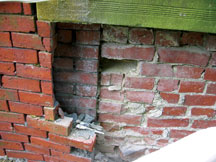
Historic Masonry
A newly approved ASTM International standard will advance the cause of architectural preservation. C1713, Specification for Mortars for the Repair of Historic Masonry, was developed by Subcommittee C12.03 on Specifications for Mortars, part of ASTM International Committee C12 on Mortars and Grouts for Unit Masonry.
John Wathne, structural engineer and president of Structures North Consulting Engineers Inc., notes that ASTM standard C270, Specification for Mortar for Unit Masonry, which was originally approved in 1951, has to date very effectively covered mortars for new construction, repairs to existing modern era structures and, to some extent, repairs to older buildings. However, many of the buildings constructed prior to the existence of C270 predate the use of modern cement and lime formulations in that standard and have become increasingly in need of repair and maintenance.
"In response, an entire industry of preservationists and maintainers has emerged, and a body of knowledge has been developed regarding the use of appropriate materials and techniques for preserving these structures based upon lessons learned thus far," says Wathne, who is chair of the task group that developed C1713.Among lessons learned and incorporated into C1713 is that new restoration materials must be visually, chemically and physically compatible with the original in situ materials being worked on as well as suitable for the application, climatic and performance requirements of the installation.
C1713 will allow specifiers to select mortars based on scientific principles and test methods in order to satisfy project-specific requirements and goals. The new standard also provides accompanying limitations and guidelines for the use of material combinations that are outside the realm of C270."It is ultimately hoped that the specified tests will provide a basis upon which a body of much-needed property data can eventually be amassed by the users and producers of common historic mortar types, thereby providing a standardized basis by which a variety of mortar types can be compared in a consistent manner, hopefully ending up in the public domain," says Wathne.
To continue to refine C1713, C12.03 is currently looking for new members. "We are looking for a well-rounded complement of specifiers, manufacturers and contractors as well as laboratory testing and quality control-related individuals; the very people who will be following the requirements set in C1713," Wathne says. The task group hopes to monitor the use and implementation of C1713, particularly because it is a standard in which the preservation community is extremely interested.
Plans for future revisions include adding an appendix that will provide supplemental guidance as to the use of the standard and an annex that will provide guidance and target values to assist specifiers in understanding materials involved in a given project.
CONTACT Technical Information: John Wathne, Structures North Consulting Engineers Inc. • Salem, Mass. • Phone: 978-745-6817 • E-mail: jwathne@structures-north.com O ASTM Staff: Kevin Shanahan • Phone: 610-832-9737 • E-mail: kshanaha@astm.org O Upcoming Meeting: June 7-9 • June Committee Week • St. Louis, Mo.Failed mortar in need of replacement.
 SN Home
SN Home Archive
Archive Advertisers
Advertisers Masthead
Masthead RateCard
RateCard Subscribe
Subscribe Email Editor
Email Editor